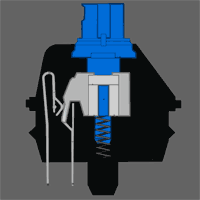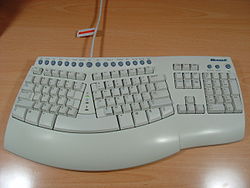Most of us don’t give our keyboards (or mice, I suppose) a second thought. Most of my keyboards tended to be budget logitechs, which while decent lack a certain something.
I preferred the ThinkPad keyboards on my laptops, but when I need to, and tend to write at a single sitting, essays that are a few thousand words long, I needed something better.
If you want a shorter version of this whole blog post,I’d advice that you look at the layout(ergonomic vs standard, and number of keys), the switch type ( membrane/scissor vs mechanical (switch or buckling spring) and Key style (full sized concave, low profile or flat).
Personally, I’m not a fan of split keyboards, or ergonomic ones. They work for some people, by putting the hands in a more natural position while typing. The split keyboard tends to separate the standard QWERTY keyboard in two (though there’s no reason you cannot use Dvorak or Colemak or your local keyboard layout with them).
Microsoft natural keyboard Pro source
A variant of that theme is the ‘bowl’ keyboard, which splits the keys into two bowl shaped depressions, popularised by the matron and kinesis advantage keyboard. The bowl keyboard design allows for fingers to reach keys with less movement, by fitting around the natural reach of a hand at rest

And finally, the Datahand, which is a pretty extreme case of ergonomic keyboards, with nearly no hand movement. It is very sci-fi looking, and supposedly incredibly comfortable once you get used to it.

There are also vertical keyboards – while some are hacked together from other keyboards, there’s purpose built ones like the Safetype.

As I said, I don’t believe in ergonomic keyboards and I’ve hardly ever had wrist strains – but if you do, it might be worth considering. Physical layout isn’t the only issue though.
Even with regular keyboards there’s variations in layout – the American and British layout QWERTY keyboards have differently shaped enter keys, and there are regional variations such as QWERTY and QWERTZ. There are also keyboards that omit the number pad (often known as tenkeyless keyboards) and have brand specific changes – my ThinkPad shifts the insert key to another key cluster, and has oversized delete and escape keys for example.

British QWERTY layout – note the inverted L shaped enter key characteristic of European keyboards. Also note the location of the backspace, @ and " keys compared to the US keyboard

US layout – note that there is no ALT GR, and the rectangular enter key.
For the seasoned typist, however, in general, you get used to one layout, and can quickly switch regardless of the physical layout – I was using a British layout keyboard as an American one for years, and when in France, I switched the layout to US, and typed QWERTY on an AZERTY keyboard.
All keyboards work off the same basic principle – you have switches of some sort in some sort of array, which when closed, is detected by some sort of microprocessor. However, since it is often not possible or necessary to have all keys detected at once, keyboards often have NKRO, or n-key rollover capability – which is the maximum number of keys detected at once. since I type two fingered this is not a major factor for me, but keyboards tend to range from 2kro to 6kro, with some keyboards claiming that they support the whole keyboard being pressed at once. Unless you have some specific application that requires you to mash multiple keys as once or type really fast, it’s a non-issue. If you need to test for nkro or if specific combinations work, Microsoft has a web based tool for that.
Most desktop keyboards these days tend to use dome switches – which are membrane switches with a rubber dome over them. They tend to be cheap (which is why they are common) and quiet compared to other technology. On the other hand, they tend to feel mushy, and you need to bottom out the keys before they register, that is to say, push them all the way down. They also generally have a good amount of travel, that is to say, you need to depress the keys all the way down to activate them. Rubber domes are the keyboards you will find on most desktops and the sort most people are used to.
Laptops and low profile keyboards tend to use scissor switches, which attach the keycaps to the boards with a ‘cherry picker’ like pair of plastic pieces, which guide the keycap to push down the dome. These tend to last longer, and while slightly more expensive than the rubber dome, have the same advantages of relatively low cost and quietness and less key travel, making them perfect for low profile designs.
The other sort of key tends to be mechanical keyboards- which are fairly uncommon, unless you go look specifically for them. Mechanical keyboards tend to be complicated. Many of them are loud, and the advantage to them is that quite often you can type faster on them and they have better feedback. They’re supposed to be pretty noisy, but I personally find that a standard cherry blue is not much worse than a membrane. Jeff Atwood has gone into the technical details of the different types of switches in this answer.
The buckling spring keyboard to many is the ‘classic’ clicky keyboard – such as the famous IBM model M or the Unicomp customizer. They use a spring that bends then buckles and causes a hammer to hit a dome. These keyboards need a good amount of force to actuate, compared to the dome keyboards, but you do not need to bottom out the keyboards. For most part only IBM and unicomp build them, so they’re unusual. These are oldschool, solidly built keyboads, and tend to have a bit of a fanatical following. They’re supposed to be loud however.

Bucking Spring Mechanism
Another common keyboard design is the switch type – with each key having an individual switch. These are more common (for example, the das keyboard, and Razer Black Widow) use this technology, as do many custom or customisable designs. Unlike buckling spring keyboards, there are variants that are silent, since many switches come in silent and non-silent versions, as well as keys with different tactile characteristics, with many keyboard enthusiasts favoring one or the other. One of the major producers of these switches is CHERRY, and many of these keyboards use their switches, so you can get some idea what to expect by doing a little homework – for example, a keyboard built using CHERRY “blues” will tend to be clicky, tactile (you can feel the resistance of the key change as you push it), and require roughly the same amount of pressure as any other cherry-blue-based keyboard to press down a key

Microswitch Mechanism – Cherry Blue
Here’s a video with a perx keyboard (representing an utterly horrid keyboard), a common Logitech and a Razer Black Widow Ultimate that uses Cherry Blues.
There are other keyboard technologies of course, but from these three we can narrow down a range of characteristics that might be useful in deciding on a keyboard. Fundamentally you’d want to look at cost, actuation force (enough to have feedback, but not enough to need to hammer on keys), key travel, noise levels, feel and layout.
| Keyboard type | Cost | Actuation Force | Key Travel | Noise | Feel |
| Dome | Low | Low | High | Low | Linear |
| Scissor Switch | Low | Low | Low | Low | Linear |
| Buckling Spring | High | High | Low | High | Tactile |
| Switch | High | Variable | Low | Variable (depends on switch) | Variable (depends on switch) |
In addition, the two mechanical switch types are activated before they bottom out, so a fast typist familiar with the keyboard can type significantly faster, and with less strain.
Recently, there have also been keyboard designs that integrate OLED displays – notably the (rather expensive) optimus maximus and popularis keyboards – these are chicklet style, but you’re able to switch between keyboard layouts on the fly. Razer also makes keyboards with some OLED keys and a multitouch display – in a sense, these are a combination of an input device and an output device.

Besides the technical fundamentals, there’s also the matter of deciding between flat and apple-style chicklet keys (on scissor keyboards), whether you need programmable macros for gaming, and various other functions. You might also want a backlit keyboard if you use a system at night a lot – quite a few chicklet-style and mechanical keyboards have this. Weight can be a factor – I chose a tiny generic mini keyboard for remote use with my personal server and troubleshooting systems (it isn’t perfect, has fewer F keys than a full or laptop keyboard which makes switching boot order a pain, but it’s light enough to slip into a dispatch bag), but favour heavier keyboards for actual typing since they are more stable and less likely to move while typing.
Personally, most of my keyboards have been dome switch, and either cheap ones which clacked loudly with massive amounts of key travel, or were silent and rather mushy or laptop keyboards, which even with the best versions, don’t have that much feel to them compared to an decent full sized keyboard. I’ve switched over to a mechanical keyboard to some extent – they’re a lot costlier, but personally I like it more. If you type a lot, getting a good keyboard can really make a difference in your experience and comfort.


I’m aware of a few teething problems on the post, to do with links and such. I’m talking to the blog editors about fixing them and it’ll be fixed as soon as we work out what exactly is wrong.
As always, the minions responsible have been taken out back and shot 😉
After executing the minions, I have hired new ones. They appears to have done their job nicely thus far.